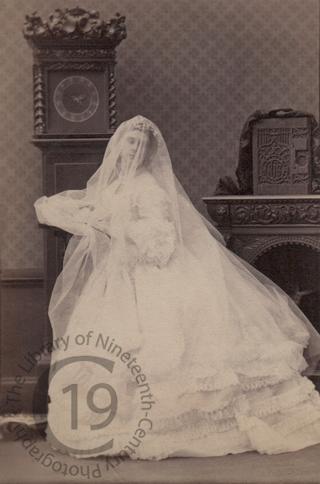
The Hon Mrs Robert Baillie Hamilton
In the Silvy daybooks the sitter is identified as ‘Mrs Baillie Hamilton (before Miss Pringle).'
Born on 28 July 1832 at Stichell in Roxburghshire, Mary Gavin Pringle was the eldest daughter of Sir John Pringle of Stichill, 5th Bt., and his wife Lady Elizabeth née Campbell.
On 18 July 1861 at St George’s, Hanover Square, she married Major the Honourable Robert Baillie Hamilton, second son of George Baillie Hamilton, 10th Earl of Haddington, and Georgina née Markham. Their marriage was childless.
The Honourable Robert Baillie Hamilton died on 5 September 1891 ‘after a long illness, date to an affection of the chest’ (Edinburgh Evening News, 7 September 1891).
The Honourable Mrs Baillie Hamilton died, aged 79, on 11 April 1912 at Langton Duns, Berwickshire.
‘Mrs Hamilton, who was born in 1832, was married in 1861. She was Mary Gavin, daughter of Sir John Pringle, Bart., of Stichill, and on the death of her mother, Lady Elizabeth Pringle (daughter of the first Marquis of Breadalbane) succeeded to the estate of Langton. Possessed of an active mind, and an intellect whose cultured tastes were ever assiduously fostered, she had a wonderful knowledge of English language, and was quick to detect the errors in composition of the careless, as well as the scarcely perceptible deviations of the accomplished scholar. Closely bound up in the beautiful Parish in which her estate lay, she was possessed of an intimate knowledge of its history, civil, ecclesiastical and political, […] Perhaps most of all she will be remembered best for her patriotism — her love of country, her devotion to her King, and most of all, her love for the army. It is not surprising that she, whose husband had held honoured rank as an officer in the army during the Crimean Campaign and afterwards in China, should retain in her heart through all the years a very special love of the soldier. For numerous and unostentatious acts of kindness, the lady of Langton will for long be remembered, not only in the homes of her servants and tenantry, where the gracious influence of kindly thought made itself evident, but also for the countless ways in which her active mind devised means whereby suffering might be alleviated, and sick worn patients cheered to a hope of betterment. […] Approaching the advanced age of 80 years she has laid aside the multifarious cares of this world and as the darkness of the night yields to the dawn of day she has, as became the mode of her life, quietly entered on her rest’ (Berwickshire News and General Advertiser, 16 April 1912).
Photographed by Camille Silvy of London on 10 August 1861.
Code: 127978




